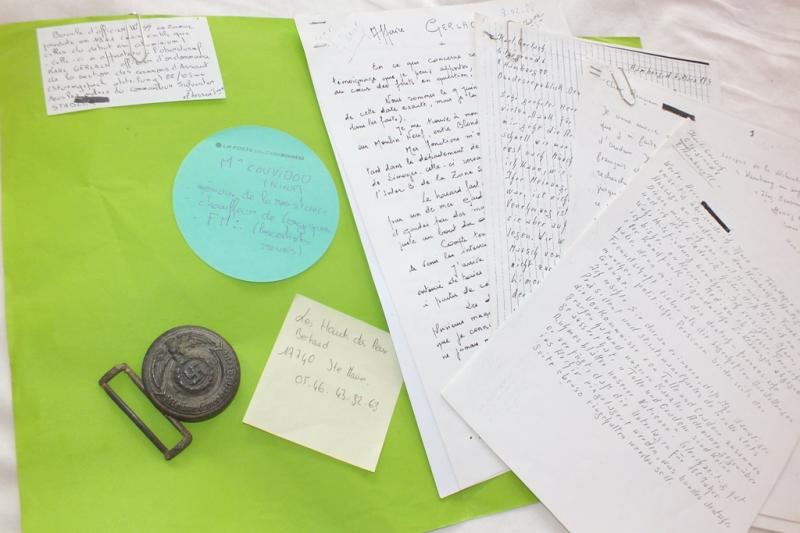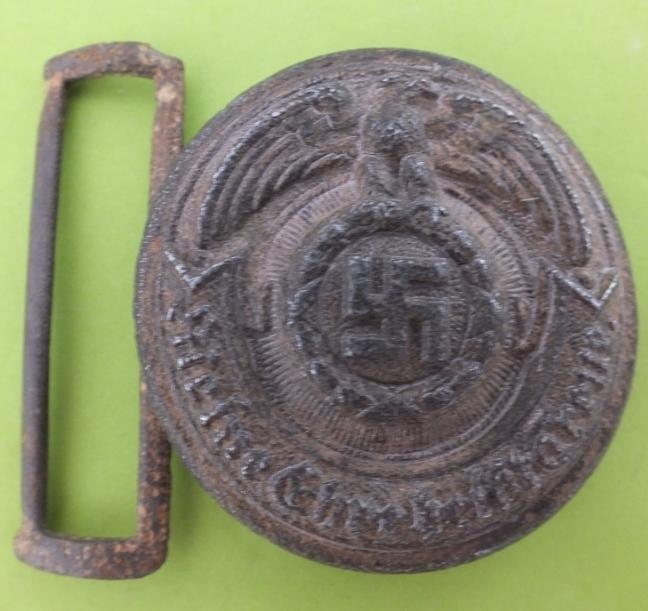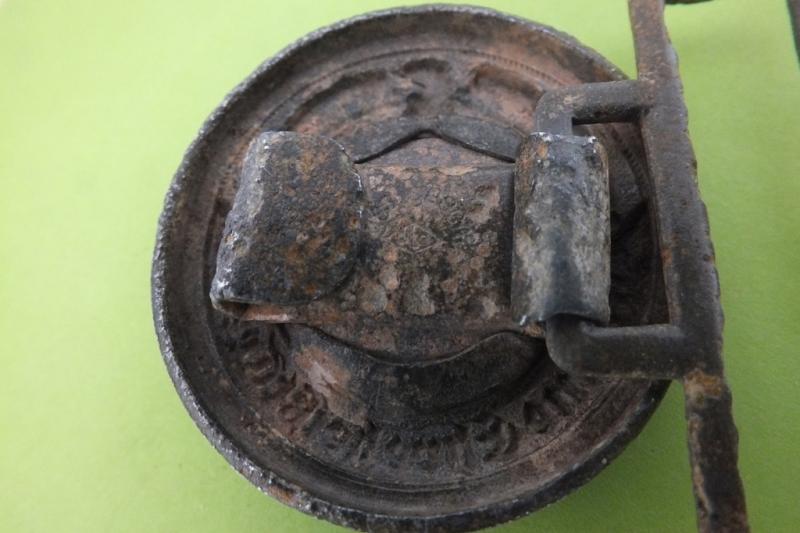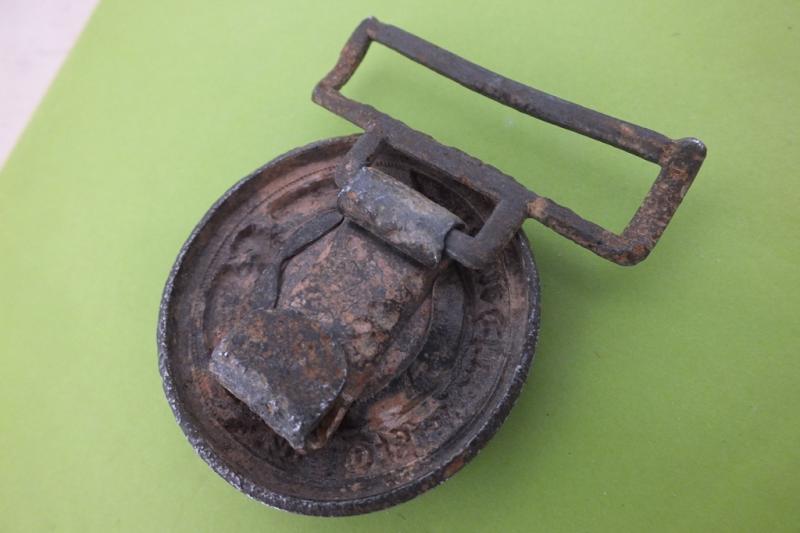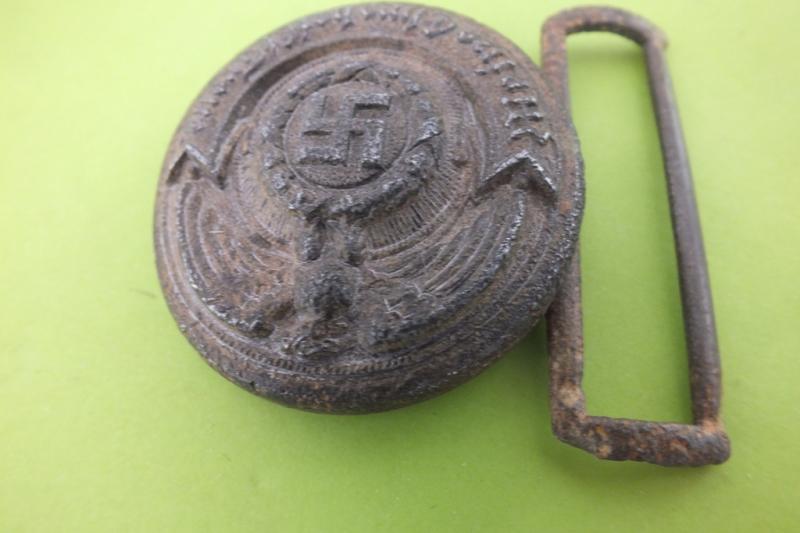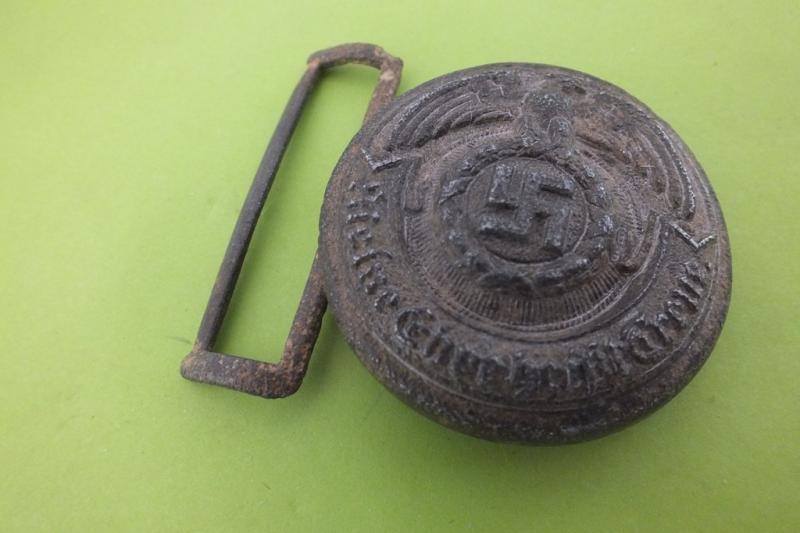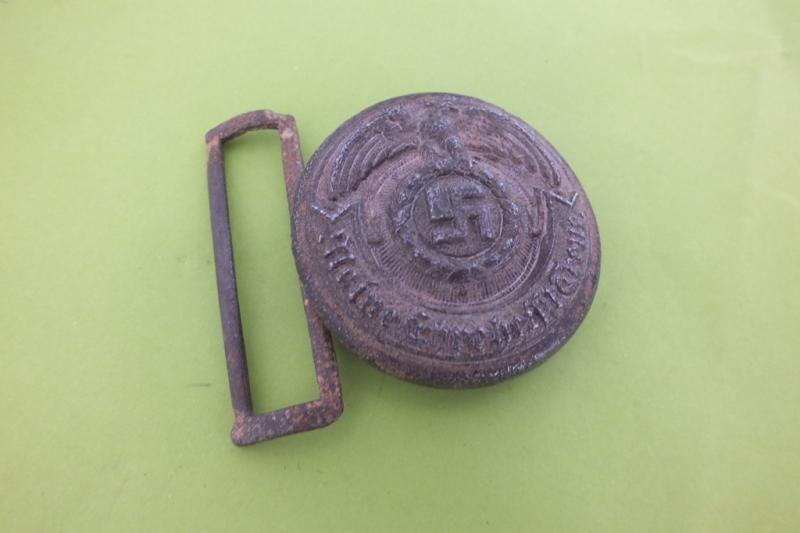WSS OFFICER BELT BUCKLE ATTRIBUTED TO DAS REICH OFFICER SS-OBERSTURMFUHRER KARL GERLACH
Zinc alloy buckle made by OLC marked to the rear buckle has been cleaned have spent some decades in the ground!
Karl Gerlach had been captured by the free French army the 9th of June 1944 near Nieul ((N/W of Limoges) when the Das Reich was in the area during its moving to the Normandy front.
He managed to escape while his driver was shot dead.
He regained his regiment in Limoges and indicated that Oradour-Sur-Glane was a city full of French free army.
The 10th of June, in the city of Oradour many were killed in reprisal.
This buckle was found some years ago in a roadside ditch during road works in the town of Nieul.
This is the only officer who lost his belt when he was captured in this sector (the other officer killed by the French free army was Kampfe the 10th of June, after Oradour attack) Only 2 known SS officers were captured in this area Gerlach and Kampf.
Gerlach was undressed when he was captured before he managed to escape and Kampf was killed by the resistance, it is unknown if he was undressed before or after his death.
The buckle was found in Nieul and it was the area where Gerlach was captured. So there is no other possibility.
This buckle comes with some documents in French including copies of 2 letters with French translation of the correspondence post war with Gerlach (include his deposition during the post war Bordeaux trial) and a copy of testimony of an officer of the free french army who saw Gerlach during his capture.
An English of Gerlachs own account:-
The Regiment, coming from the south of France, arrived in Limoges during the night of 8/9 June 1944. On the morning of 9 June I received orders from regimental commander Stadler in Limoges to prepare quarters for the assault-gun battalion in the area of Nieul. He instructed me with reference to the map and warned me about the resistance fighters who were active in the area.
I then drove to Nieul with six men in three cars. There we prepared quarters but because the location was not big enough, with reference to the map we drove to the neighbouring communities. My car was faster than the other two. Therefore I soon had to halt and because the others were not following, I turned back to find them. After a short stretch I was suddenly stopped on the open road by a lorry in which I recognised military uniforms. For a second I thought they were friends, because we had been told that Frenchmen in militia uniform were fighting on our side. Before I was able to consider any further, let alone make use of my sub-machine gun, seven or eight uniformed men had jumped out of the lorry, trained their weapons on us and were approaching my car shouting and calling for us to put our hands up.
They dragged my driver and myself out of the car, tore the uniforms from our bodies, hit us in the face and said, accompanied by quite unmistakable gesticulations: 'SS-finished now'.
All we had on was our underwear. They shoved us off the road as we were into a thicket. I was convinced that they would shoot us straight away, so I tried to get a word in and explain something to them, first to their leader, a tall slim man in his early thirties and wearing militia uniform.
He did not seem to understand me at all because all he said was: 'No SS! SS finished!' So I spoke to a younger man who spoke relatively good German, obviously an Alsatian and who seemed to feel sorry for us, but that did not help either. I then stated that I was an orderly officer of the division and that I could give them important information if they brought me to their Marquis (sic) commander. That seemed to make an impression on the Alsatian who translated it to his leader. The latter looked at me and said something to me, but I was unable to understand.
My driver and I were dragged back to the lorry. We were told to get in and drove off with our armed escort. After a while I saw some village signs and was able to get my bearings. Then came a sign at the beginning of a village, which read: Oradour-sur-Glane. Here we halted in the main street. We had to get out and were surrounded by Marquis (sic) and a lot of curious onlookers. I noticed a lot of people in uniform, even women with yellow jackets and steel helmets. The atmosphere became more threatening from minute to minute and one of the uniformed men therefore had us brought back to the lorry. I saw ropes being brought out of a barn next to a bakery in the main street. My driver and I were made to get down from the lorry again and were bound with the ropes, with both arms behind our backs; the knots were additionally secured with wire. We stood like this for about three-quarters of an hour. Then two French civilians came along on a tandem. They spoke to the assembled people and we had to get back into the lorry.
The men who had captured us still accompanied us as guards. We drove away from Oradour-sur-Glane, the tandem about a hundred metres in front and constantly giving us signs. We stopped for the first time at a house on whose front there was a telephone sign. The two civilians riding the tandem telephoned from here. They returned to the lorry and explained something to what seemed to be the leader of our escort.
We then drove off the main road to the left into an area that was quite without any buildings. After three or four kilometres we were dropped off at a picket, the ropes were undone and we were given something to eat. The lorry with our escort drove on and came back about two or three hours later. We were again tied up and got back onto the lorry.
We continued for eight to ten kilometres to a glade in the forest where I saw a milestone reading: 6.5 km to Bellac. We turned of the road into this glade and in about 300 metres further on came upon a French lorry bearing the tricolour.
Here we were again dragged out of the lorry and badly mistreated. We were hauled before a young Marquis (sic), wearing a blue uniform who appeared to be the commander.
We were not interrogated, he simply shouted at us: 'SS nix listen, finished now'. The young Alsatian, one of our escorts tried to intervene but the commander snapped at him very harshly. The commander then called to some other Frenchmen, also wearing blue uniforms and as far as I could make out from the signs and movements gave them orders to lead us into the woods and shoot us. My driver quite clearly realised what was going on and struggled and tried to resist being taken away. The Frenchmen standing around us became infuriated and set about him. I grabbed the opportunity and dashed for the nearby woods. I ran for all I was worth, I ran for my life. I heard shots and as I turned round I saw my driver slump to the ground. I plunged onwards, seeking cover behind trees and bushes. They pursued me and I could hear them shouting behind me; several shots whistled past my head. I changed direction constantly. Through this deception and the cover of falling night I managed to escape.
I had carefully studied the map before leaving Limoges, so I knew that I must come across the railway line between Bellac and Limoges. I did reach it and the next morning, 10 June, I arrived at the command post in Limoges.
I reported to regimental commander Stadler and described what had happened. He told me that I was not the only one who had been attacked and kidnapped on the preceding day. The commander of III battalion Der Führer, an officer named Kämpfe, had not yet returned and was probably dead. The regimental commander told me to have a good rest because we had a difficult march before us.
When I got up the commander of I battalion Der Führer, Diekmann, got me to show him on the map the spot where I had been captured and the way to the place where my driver had been shot. He left soon thereafter with the 3rd company, under the command of Hauptsturmführer Kahn, in the direction of Oradour-sur-Glane.
Reserved CS
Code: 5970


